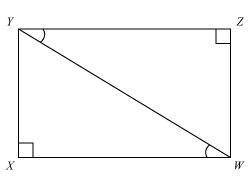Given: ∠XWY ≅ ∠ZYW ∠X and ∠Z are both right angles.
Prove: YXW ≅ WZY
A. Given: ∠XWY≅∠ZYW...

Mathematics, 06.12.2020 23:50 stefan19367
Given: ∠XWY ≅ ∠ZYW ∠X and ∠Z are both right angles.
Prove: YXW ≅ WZY
A. Given: ∠XWY≅∠ZYW , ∠X and ∠Z are both right angles.
∠X≅∠Z ; they have the same measure.
∠XYW≅∠ZWY ; alternate interior angles of parallel lines.
WY¯¯¯¯¯¯¯≅WY¯¯¯¯¯¯¯ ; Reflexive Property of Congruence.
YXW≅WZY by SAS
B. Given: ∠XWY≅∠ZYW , ∠X and ∠Z are both right angles.
∠X≅∠Z ; they have the same measure.
WY¯¯¯¯¯¯¯≅WY¯¯¯¯¯¯¯ ; Reflexive Property of Congruence.
YXW≅WZY by AAS
C. Given: ∠XWY≅∠ZYW , ∠X and ∠Z are both right angles.
∠X≅∠Z ; they have the same measure.
WY¯¯¯¯¯¯¯≅WY¯¯¯¯¯¯¯ ; Reflexive Property of Congruence.
YXW≅WZY by SAS


Answers: 2


Another question on Mathematics

Mathematics, 21.06.2019 17:00
In tossing one coin 10 times, what are your chances for tossing a head? a tail? 2. in tossing one coin 100 times, what are your chances for tossing a head? a tail? 3. in tossing one coin 200 times, what are your chances for tossing a head? a tail? deviation = ((absolute value of the difference between expected heads and observed heads) + (absolute value of the difference between expected tails and observed tails)) divided by total number of tosses. this value should always be positive. 4. what is the deviation for 10 tosses? 5. what is the deviation for the 100 tosses? 6. what is the deviation for 200 tosses? 7. how does increasing the total number of coin tosses from 10 to 100 affect the deviation? 8. how does increasing the total number of tosses from 100 to 200 affect the deviation? 9. what two important probability principles were established in this exercise? 10. the percent of occurrence is the obtained results divided by the total tosses and multiplied by 100%. toss the coins 100 times and record your results. calculate the percent occurrence for each combination. percent head-head occurrence: percent tail-tail occurrence: percent head-tail occurrence:
Answers: 3

Mathematics, 21.06.2019 22:30
Given the system of equations presented here: 2x + 4y = 14 4x + y = 20 which of the following actions creates an equivalent system such that, when combined with the other equation, one of the variables is eliminated? multiply the second equation by â’4 to get â’16x â’ 4y = â’80 multiply the second equation by â’1 to get â’4x â’ y = â’20 multiply the first equation by 2 to get 4x + 8y = 28 multiply the first equation by â’1 to get â’2x â’ 4y = â’14
Answers: 1

Mathematics, 22.06.2019 04:00
Brad earns $12.75/hr and works 40 hours a week. what is his gross annual income?
Answers: 1

Mathematics, 22.06.2019 05:00
Simplify each expression using the definition, identities, and properties of imaginary numbers. match each term in the list on the left to its equivalent simplified form on the right. 1. (i 3)2(-i 0)3(3i 2)4 -4 2. (i 3i -5)2(i 4i -3)0 1 3. (-i 4i 2)(2i)2(i -1i 5)3(i 0)-3 -i 4. i 3[(i 2i 3i 4)(i 0i 2i 5)]2 81
Answers: 2
You know the right answer?
Questions



Mathematics, 15.07.2019 11:00



Social Studies, 15.07.2019 11:00

Mathematics, 15.07.2019 11:00


Social Studies, 15.07.2019 11:00

Mathematics, 15.07.2019 11:00

Mathematics, 15.07.2019 11:00



Mathematics, 15.07.2019 11:00


Mathematics, 15.07.2019 11:00

Social Studies, 15.07.2019 11:00


English, 15.07.2019 11:00



